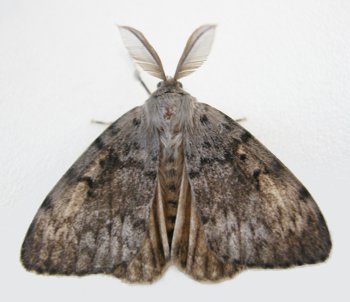Pests
Ocneria dispar (L.) - Gypsy Moth.
Systematic position.
Class Insecta, order Lepidoptera, family Lymantriidea, genus Lymantria. The subspecies L. d. asiatica Wnukowsky is recognized in Siberia, as is L. d. praeteria Kard. in the Far East.Synonyms.
Lymantria dispar (L.), Portheria dispar (L.).Biological group.
Polyphagous pest of all fruit crops and forest trees.Morphology and biology.
Imago sexually dimorphic: female wings dirty-white with black, zigzagging lines (wingspan of 75 mm); male wings brownish gray with wide cross stripes (wingspan of 45 mm). Female abdomen thick, massive, covered with dense black hairs; male abdomen thin; male antennae plumose. Hind wings brown, with lighter fringe. Average fecundity is 300-600 eggs, maximum 1200; up to 700 eggs in one batch. Females lay eggs, interweaving and covering them with abdominal hairs so that batches resemble small, golden brown pillows. Moths attach the batches to trunks of trees, fences, etc. During mass reproduction, the females lay eggs in casual places, i.e., on stones, stubs, dry, wind-fallen trees, etc. In Siberia, the batches are frequently located on the northern sides of trunks, which subsequently provides synchronization of caterpillar-hatching with the beginning of growth of main host plants. Embryonic development lasts 24-30 days. Caterpillar-hatching is long-term (about one month) in the spring, occurring when daily average temperatures reach 6°C or higher; hatching occurs in the beginning of April (plains of Central Asia), at the end of April (Ukraine, Central European parts of Russia, mountains of Central Asia, the Far East), and in the beginning of May (Southeastern Siberia). Young caterpillars are covered with very long hairs, which exceed the size of the body and promote carriage by wind for significant distances. Hatching caterpillars creep along trunks into crown, where they eat appearing leaves. Pupation occurs at the end of spring or in the beginning of summer on branches and trunks of trees. Pupae bright yellow with black spots and dots, attached to a substratum with the help of a silk belt; head directed upwards. The pupal phase lasts about 2 weeks. Diapausing eggs winter during the stage of quite developed caterpillars in egg capsules on trunks and thick boughs.Distribution.
Transpalearctic species. Inhabits Western Europe (except for the Far North), Asia Minor, northern Iraq, Iran, northern Mongolia, northeastern and central China, Japan (Hokkaido, Honsyu), Korea, Northern Africa, North America (southeastern Canada and USA) (introduced), the Baltic countries, Byelorussia, Ukraine, Moldova, Transcaucasia, Kazakhstan, and Central Asia (in mountains mainly). In Russia, it is distributed throughout the European region (except in the north), the Northern Caucasus, southern Ural, Transbaikalia, southern Siberia, and the Far East, including the Amur Region, the Primorskii and Khabarovsk Territories, Sakhalin, and S. Kurils (Kunashir, Shikotan, Iturup).Ecology.
Everywhere monovoltine. Moth flight begins at the end of June in Ukraine; in the beginning of July in the Moscow Region and in the plains of southern Siberia; in the 2nd half of July in the Primorskii Territory; in the beginning of August in the mountains of Siberia. Everywhere the period of flight is long-term, depending on species location, exposition of slopes, availability of host plants, etc. Moths (as well as young caterpillars) are passive migrants, found hundreds of kilometers away from the centers of mass reproduction. Optimum conditions for the imago are temperatures of 23-29°C, wind velocity of 2-4 m/s, cloudiness ranging from 3-10 points, and limited rains. Fecundity is more than 500 eggs. Eggs pass through summer-autumn-winter diapause. Northern populations need enough warmth in autumn and moderate cold (below 0°C) at the beginning of winter for the formation of caterpillars during egg and normal diapause. Southern populations have a shorter period of diapause, without cooling. The pest is characterized by ecological plasticity, i.e., local types in each habitat somewhat differ in food specialization and caterpillar-hatching. The developed caterpillars in eggs are highly frost-resistant, tolerating frosts as cold as -50°C.Economic significance.
Polyphagous caterpillars damage more than 600 plant species of 98 botanical families. Plants of 5 botanical families are the most preferable to the pest, such as Rosaceae, Fagaceae, Betulaceae, Salicaceae, Pinaceae, Rutaceae, Aceraceae and Tiliaceae. Caterpillars eat buds, leaves and generative organs. They eat top leaves of trees containing tannins and avoid plants rich in alkaloids, terpenes and volatile oils. Among fruit crops, apple, pear, cherry, and sweet cherry are more often damaged, as is apricot in the Far East and Central Asia. Caterpillars cause harm everywhere to all other Rosaceae, grapes, walnut and fig. Harm is also reported on maize and other field cultures. Control measures include insecticide treatments against hatching caterpillars before flowering of fruit crops. Synthetic sex attractants are recommended for pest survey.Related references.
Batiashvili I.D. 1965. Pests of continental and subtropical fruit crops. Tbilisi: Ganatleba, 336 p. (In Russian)Chistyakov Yu.A. 1988. Family Lymantriidae. In: Kirpichnikova, V.A. & Ler, P.A., eds. Butterflies - pests of the Far Eastern agriculture. Keys. Vladivostok: DVO AN SSSR, p. 189-209 (in Russian).
D'yakonov A.M. & Kozhanchikov I.V. 1949. Lepidoptera. In: Pavlovskii E.N. & Shtakelberg A.A., eds. Pest Animals of Middle Asia (handbook). Moscow & Leningrad: AN SSSR: 179-198 (in Russian).
Kuznetsov V.I. 1999. Lymantriidae (Liparidae, Orgyidae). In: Kuznetsov V.I., ed. Insects and mites - pests of agricultural plants. V. 3(2). Lepidoptera. St.Petersburg: Nauka: 279-320 (in Russian).
Nekrutenko Yu.P. 1974. Lymantriidae. In: Vasil'ev V.P., ed. Pests of agricultural crops and forest plantations. V.2. Arthropods. Kiev: Urozhai: 357-361 (in Russian).
Prokof'ev M.A. 1987. Siberian orchards protection against pests. Moscow: Rossel'khozizdat, 239 p. (in Russian).
Vasil'ev V.P., Livshits I.Z. 1984. Pests of fruit crops. Moscow: Kolos, 399 pp. (In Russian)


